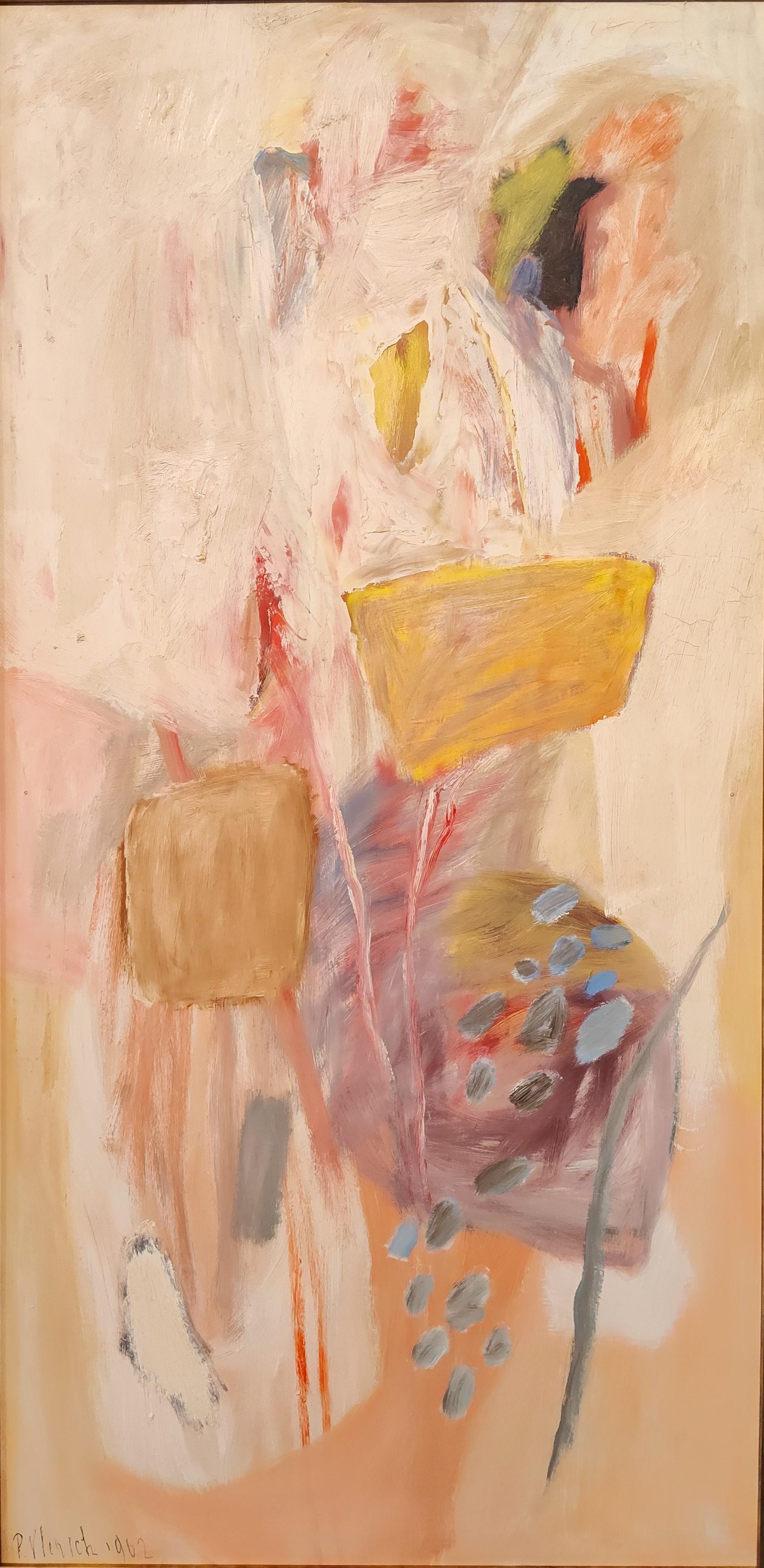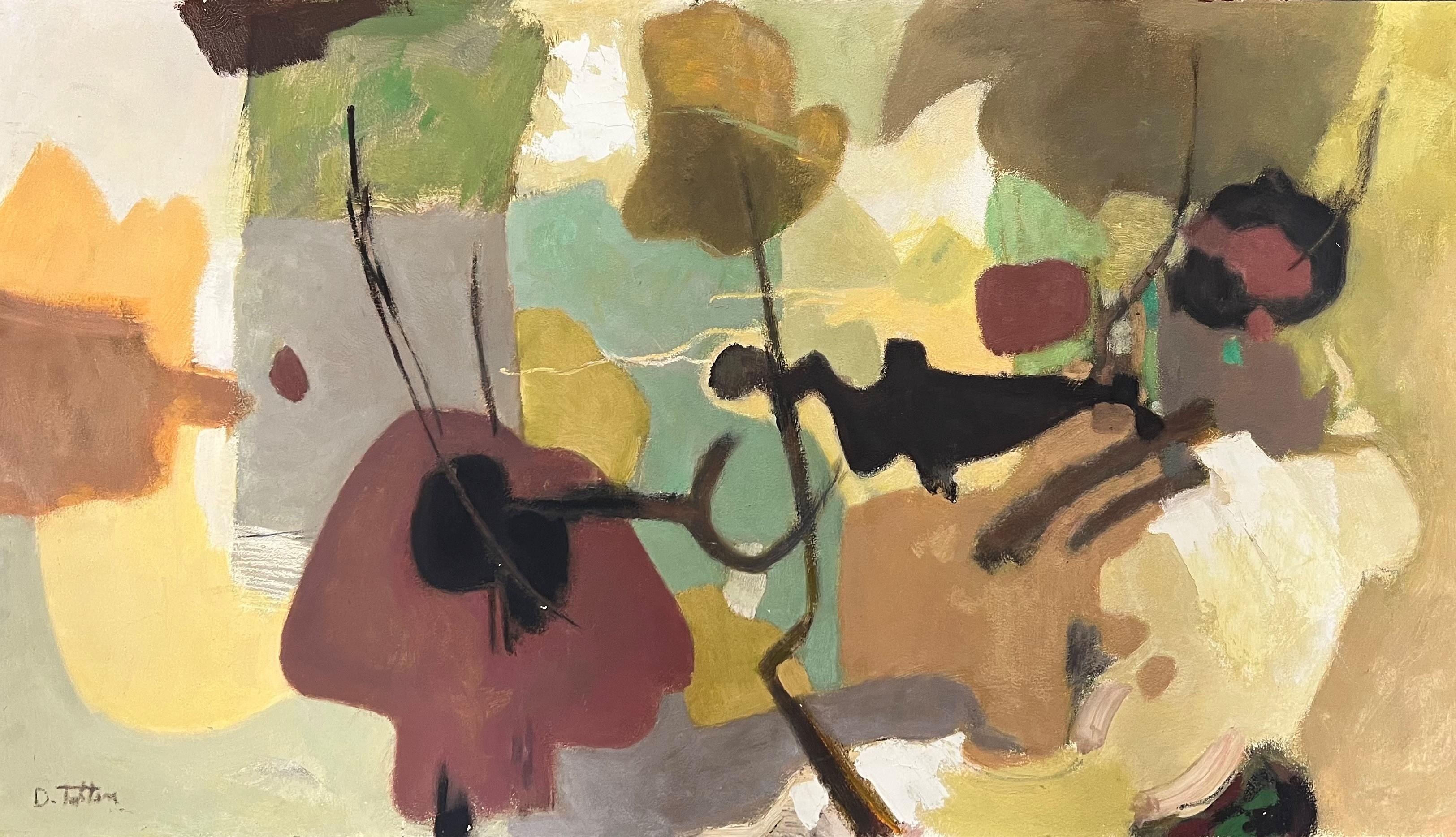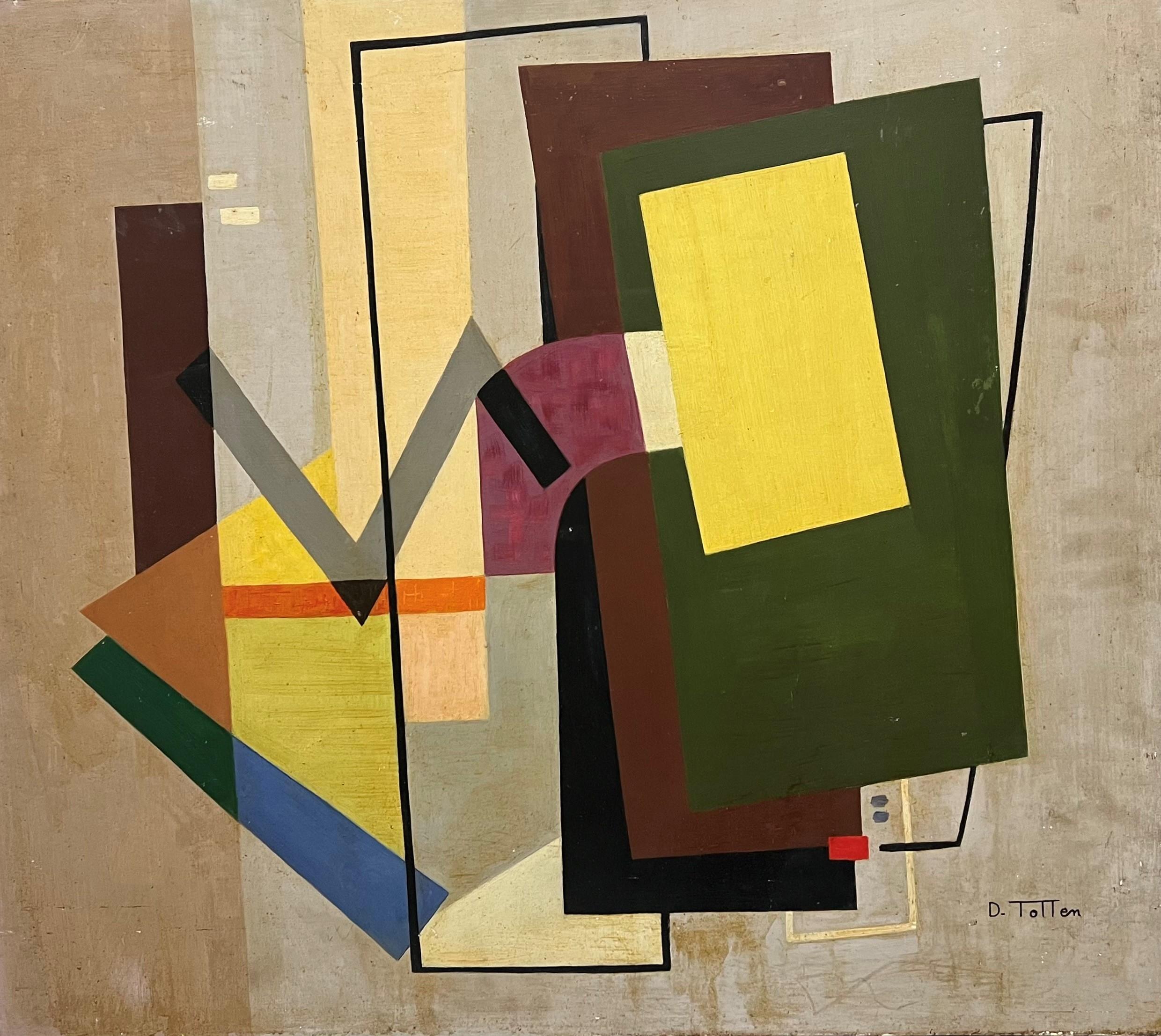Items Similar to Abstract Impressionistic painting on board Ineffable by Pierre Vlerick
Want more images or videos?
Request additional images or videos from the seller
1 of 10
Pierre VlerickAbstract Impressionistic painting on board Ineffable by Pierre Vlerick
About the Item
This painting is a perfect example of lyrical abstraction and a choice painting out of the best period of Vlerick's career.
Ineffable, 1962
Oil on Masonite board
91,5 x 61,5 cm (without frame) 93 x 63 cm (framed)
Signed and dated Top Right ‘P. Vlerick 1962’
with title, signature place and date at the back:
Ineffable P. Vlerick Afsnee 1962
Pierre Vlerick’s work shows some resemblance to Willem de Kooning’s. While the Dutch American was famed for the wild manner in which he treated his canvas, Pierre Vlerick showed some more restraint, but making a painting was in any case a slow process of stopping and starting and revising. His exploration is meant to result in a correct proportion of colour fields and streaks, often applied layer upon layer. All his colors have a luminous intensity. It was mainly Bonnard’s colorful work that inspired Vlerick to compose his own singular range of colors of slightly tingling yellows, greens, oranges and bits of blue here and there. Abstraction is emphasized by his use of color. Colors not associated with objects from daily life often dominate the composition: purple, for instance. This is the basis for his continuing abstraction, ending up as color fields combined with organic elements depicted with the vaguest of contours.
Though both artists create a very metropolitan, say even worldly art, their work evokes nature. De Kooning has been called a master of ‘abstract landscape’. The structure of Vlerick’s works, too, is very vegetable and organic. No wonder he referred to his paintings as his ‘gardens’. Neither artist allowed his garden to remain empty: de Kooning created a female figure looking like a cross between a floozy and the mother goddess. Vlerick imagined a woman who is enjoying her body. Vlerick’s approach to abstract art is the same as de Kooning’s; they refuse to paint in a figurative manner, yet at the same time do not wish to renounce referring to reality.
De Kooning once put it very accurately during an interview when he conceded that painting the human figure any longer was absurd(in the post-war period), but also stated that it would be even more absurd not to do it. The only way out of this ambiguous dilemma is the deconstruction of the human figure. Not in order to reject it, but to show it in all its fragility.
Pierre Vlerick’s exceptional artistic talents were already recognized while he was studying at the Ghent Academy (1940-1944) whereupon graduating he received a gold medal.
In 1947-1948 Vlerick enrolls at the “la Grande Chaumière Academy”, a Parisian private academy which attracts lots of foreign artists thanks to the reputation of its most important teachers such as Maurice Denis (1870-1943). Denis was one of the founding fathers of “the Nabis” and is also considered to be the godfather of abstract art by many artists and art critics. Maurice Denis is famous for his quote: "Remember that a painting, before it is any kind of representation, is essentially a flat surface covered with colors in a certain collected order."
At La Grande Chaumière, Vlerick is challenged to develop a pictorial language of his own. Vlerick develops a way to translate the observed reality into visions of color and form, which can be situated somewhere on the axis between the figurative and the abstract. Reality is decomposed and reconstructed into a complete new representation.
After a trip to Spain in 1955 the painter evolves towards the use of brighter colors. At the Brussels World Exhibition of 1958 (Expo 58) Vlerick is for the first time confronted with real works of 17 American artists (William Baziotes, James Brooks, Sam Francis, Arshile Gorky, Adolph Gottlieb, Philip Guston, Grace Hartigan, Franz Kline, Willem de Kooning, Robert Motherwell, Barnett Newman, Jackson Pollock, Mark Rothko, Theodoros Stamos, Clyfford Still, Bradley Walker Tomlin and Jack Tworkov) and he is deeply impressed. This event pushes him even further into the direction of abstraction and from 1959 onwards Pierre Vlerick radically evolves towards a lyrical abstraction. His abstract paintings from the first half of the 1960s are experimental and raw in their treatment of space and surface and bewitching with their use of dazzling colors.
In the early 1960s the artist starts exhibiting abstract impressionist works at international shows such as the Carnegie Institute, (Pittsburgh 1961/1962); The Corcoran Gallery, (Washington D.C.1963) ; Venice Biennale (Belgian Pavilion), (Venice 1964); Musea de Arte Moderna, (Rio de Janeiro,1965).
Vlerick obtains a Fulbright scholarship, which enables him to stay in the States in 1964 and 1968. He also briefly teaches at the Harvard University in Boston. At the same time, Vlerick collaborated in curating the Forum exhibitions in Ghent in 1961-62-63, where the European avant-garde was prominently shown. This allowed him to be in close contact with the artists and their ideas.
To his credit, his work always remained very personal and original. Vlerick’s work is far removed from the explicitness of expressionism, from the sharp delineations of surrealism, from the angular multi-perspectives of cubism or the cool rationality of conceptualism. He is closer to the myopic outlook on the world typical of an impressionist’s observation and depiction of the world. The way he allows bright colours to fertilise one another is not far removed from Fauvism. And with Lyrical Abstraction, he shares the nerve to let compositions run out of control. One thing is resoundingly clear; he belongs to a post-1945 generation that did not feel like surrendering to the constraints of any one style.
- Creator:Pierre Vlerick
- Dimensions:Height: 36.62 in (93 cm)Width: 24.81 in (63 cm)Depth: 1.97 in (5 cm)
- Medium:
- Period:
- Condition:
- Gallery Location:Gent, BE
- Reference Number:1stDibs: LU2140213726402
About the Seller
5.0
Vetted Seller
These experienced sellers undergo a comprehensive evaluation by our team of in-house experts.
Established in 2018
1stDibs seller since 2022
Typical response time: 16 hours
- ShippingRetrieving quote...Ships From: Gent, Belgium
- Return PolicyA return for this item may be initiated within 10 days of delivery.
More From This SellerView All
- Impressionism painting No nightshade Oil on panel by Pierre VlerickLocated in Gent, VOVThis painting is a perfect example of lyrical abstraction and a choice painting out of the best period of Vlerick's career. Geen nachtschade (No Nightshade), 1962 Oil on Masonite board 121 x 61 cm (without frame) 136 x 75 cm (framed) Signed and dated bottom left ‘P. Vlerick 1962’& with title, signature place and date at the back Pierre Vlerick...Category
1960s Abstract Impressionist Abstract Paintings
MaterialsMasonite, Oil
- Impressionism painting 4 Oil on panel by Pierre Vlerick (1923 - 1999)Located in Gent, VOVThis painting is a perfect example of lyrical abstraction and a choice painting out of the best period of Vlerick's career. Pierre Vlerick’s work shows...Category
1960s Abstract Impressionist Abstract Paintings
MaterialsMasonite, Oil
- Impressionism painting 21 Oil On Panels by Pierre Vlerick (1923 - 1999)Located in Gent, VOVThis painting is a perfect example of lyrical abstraction and a choice painting out of the best period of Vlerick's career. Pierre Vlerick’s work shows...Category
1960s Abstract Impressionist Abstract Paintings
MaterialsMasonite, Oil
- The Chapel Of Protection In CagnesBy Paul LeducLocated in Gent, VOVLa Chapelle de la Protection in Cagnes, circa 1925 Oil on panel, signed with the monogram lower left 27 x 34.5 cm Bibliography: The Painters of Cagnes, exhibition catalogue, Château-Musée Grimaldi, 2011, p.62 Paul Leduc...Category
1920s Impressionist Landscape Paintings
MaterialsOil, Panel
- Lady in a red dress with a kittenLocated in Gent, VOVSignature lower right: J. Bail Relined and some restorations Joseph-Claude Bail was born during a period of intense disagreement in the Parisian art world. For several years the Salon juries had rejected many progressive artists works; printmaking was making a charge at establishing itself as a true art form; the Barbizon group of painters challenged the tradition of historical landscapes with their views of the modern countryside, and Realism was decades old and had brought forth such combative figures as Gustave Courbet. Yet not all artists can be said to belong to this modern view of the nineteenth century. Numerous artists found prestige and public acclaim both at the Salons and with the public with works that relied on past styles and traditions influenced by the “Little Masters” from seventeenth-century Holland and traditions from eighteenth-century France. Joseph Bail...Category
Late 19th Century French School Figurative Paintings
MaterialsOil
- On the banks of the Meuse near Waulsort by François Roffiaen (1820-1898)Located in Gent, VOVOn the banks of the Meuse, near Waulsort (before the canalization of the Meuse) Signed lower right François Roffiaen (1820-1898): A Life in Brushstrokes His kin, born from humble s...Category
19th Century Landscape Paintings
MaterialsOil
You May Also Like
- "Harmony" DiptychBy Richard W. DempseyLocated in Washington, DCA pair of abstract modern paintings by Richard W. Dempsey (1909 - 1987). Paintings are oil on masonite and signed "Dempsey" front bottom corner. On the back of each painting on tape is written "Harmony". Richard Dempsey was born in Ogden, Utah, on September 14, 1909. His youth was spent in Oakland, CA, where he attended Sacramento Junior College (1929-31) as an art major. He then studied at The California School of Arts and Crafts (1932-34) and the Students Art Center (1935-40), where he was taught by the sculptor Sargent Johnson. In 1941, he moved to Washington, DC and studied at Howard University...Category
1950s Abstract Abstract Paintings
MaterialsMasonite, Oil
- PassageLocated in Irvine, CA"Passage" by Don Totten is an abstract oil painting on masonite circa 1960 and measures 24 in x 24.5 in. There are faint spots on the upper right corner of the painting but otherwise...Category
1960s Abstract Abstract Paintings
MaterialsMasonite, Oil
- LyricLocated in Irvine, CA"Lyric" by Don Totten circa 1960, oil on masonite and measures 18 in x 32 in. This piece is in excellent condition. Donald C. Totten (1903-1964) was a mem...Category
1960s Abstract Abstract Paintings
MaterialsMasonite, Oil
- CompositionLocated in Irvine, CA"Composition" by Don Totten is an abstract oil painting on masonite circa 1950 and measures 28 in x 32 in. The painting is in good condition. Donald C. To...Category
1950s Abstract Abstract Paintings
MaterialsMasonite, Oil
- Ceremonial Dancers oil and tempera painting by Julio De DiegoBy Julio de DiegoLocated in Hudson, NYArtwork measures 48" x 30" and framed 56 ¼" x 38 ¼" x 3" Provenance: John Heller Gallery, NYC, circa 1975 (label verso) The artist's daughter Corbino Galleries, Sarasota, FL (1990)...Category
1940s Modern Abstract Paintings
MaterialsMasonite, Oil, Tempera
- The Magician oil and tempera painting by Julio de DiegoBy Julio de DiegoLocated in Hudson, NYJulio De Diego’s Atomic Series paintings made an extraordinary statement regarding the shock and fear that accompanied the dawn of the nuclear age. In the artist’s own words, “Scientists were working secretly to develop formidable powers taken from the mysterious depths of the earth - with the power to make the earth useless! Then, the EXPLOSION! . . . we entered the Atomic Age, and from there the neo-Atomic war begins. Explosions fell everywhere and man kept on fighting, discovering he could fight without flesh.” To execute these works, De Diego developed a technique of using tempera underpainting before applying layer upon layer of pigmented oil glazes. The result is paintings with surfaces which were described as “bonelike” in quality. The forms seem to float freely, creating a three-dimensional visual effect. In the 1954 book The Modern Renaissance in American Art, author Ralph Pearson summarizes the series as “a fantastic interpretation of a weighty theme. Perhaps it is well to let fantasy and irony appear to lighten the devastating impact. By inverse action, they may in fact increase its weight.” Exhibited 1964 Marion Koogler McNay Art Institute, San Antonio, Texas This work retains its original frame which measures 54" x 42" x 2" About this artist: Julio De Diego crafted a formidable persona within the artistic developments and political struggles of his time. The artist characterized his own work as “lyrical,” explaining, “through the years, the surrealists, the social-conscious painters and the others tried to adopt me, but I went my own way, good, bad or indifferent.” [1] His independence manifested early in life when de Diego left his parent’s home in Madrid, Spain, in adolescence following his father’s attempts to curtail his artistic aspirations. At the age of fifteen he held his first exhibition, set up within a gambling casino. He managed to acquire an apprenticeship in a studio producing scenery for Madrid’s operas, but moved from behind the curtains to the stage, trying his hand at acting and performing as an extra in the Ballet Russes’ Petrouchka with Nijinsky. He spent several years in the Spanish army, including a six-month stretch in the Rif War of 1920 in Northern Africa. His artistic career pushed ahead as he set off for Paris and became familiar with modernism’s forays into abstraction, surrealism, and cubism. The artist arrived in the U.S. in 1924 and settled in Chicago two years later. He established himself with a commission for the decoration of two chapels in St. Gregory’s Church. He also worked in fashion illustration, designed magazine covers and developed a popular laundry bag for the Hotel Sherman. De Diego began exhibiting through the Art Institute of Chicago in 1929, and participated in the annual Chicago Artists Exhibitions, Annual American Exhibitions, and International Water Color Exhibitions. He held a solo exhibition at the Art Institute of Chicago in the summer of 1935. Though the artist’s career was advancing, his family life had deteriorated. In 1932 his first marriage dissolved, and the couple’s young daughter Kiriki was sent to live with friend Paul Hoffman. De Diego continued to develop his artistic vocabulary with a growing interest in Mexican art. He traveled throughout the country acquainting himself with the works of muralists such as Carlos Merida, and also began a collection of small native artifacts...Category
1940s American Modern Abstract Paintings
MaterialsMasonite, Oil, Tempera





